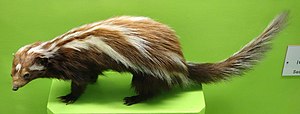줄무늬족제비
|
| ||
|---|---|---|
 줄무늬족제비 | ||
| 생물 분류ℹ️ | ||
| 계: | 동물계 | |
| 문: | 척삭동물문 | |
| 강: | 포유강 | |
| 목: | 식육목 | |
| 아목: | 개아목 | |
| 과: | 족제비과 | |
| 아과: | 그리슨아과 | |
| 속: | 줄무늬족제비속 | |
| 종: | 줄무늬족제비 (I. striatus) | |
| 학명 | ||
| Ictonyx striatus | ||
| (Perry, 1810) | ||
| 아종 | ||
| ||
| 줄무늬족제비[1]의 분포 | ||
 줄무늬족제비의 분포 지역 | ||
| 보전상태 | ||
|
| ||
줄무늬족제비(striped polecat, Ictonyx striatus)는 족제비과에 속하는 포유류의 일종이다. 아프리카긴털족제비(African polecat) 또는 조릴, 조릴라(zoril, zorille, zorilla), 케이프긴털족제비(Cape polecat), 아프리카스컹크(African skunk) 등으로도 불린다. 족제비과에 속하지만, 실제는 스컹크과(Mephitidae)의 스컹크를 다소 닮았다.[3] "조릴라"(zorilla)라는 이름은 "여우"(fox)를 의미하는 스페인어 "조로"(zorro)에서 유래했다. 콩고 분지와 서아프리카의 해안 지대를 제외한 중부아프리카와 남아프리카 그리고 사하라 이남 아프리카의 사바나 지역과 개활지같은 메마르고 건조한 불모(不毛) 지대 기후 지역에서 주로 서식한다.[2][4]
각주[편집]
- ↑ Wozencraft, W.C. (2005). “Ictonyx striatus”. Wilson, D.E.; Reeder, D.M. Mammal Species of the World: A Taxonomic and Geographic Reference (영어) 3판. 존스 홉킨스 대학교 출판사. 532–628쪽. ISBN 978-0-8018-8221-0. OCLC 62265494.
- ↑ 가 나 Stuart, C., Stuart, T. & Hoffmann, M. (2008). Ictonyx striatus. 2010 IUCN 위기종의 적색 목록. IUCN 2010. 2010년 7월 30일 내려받음.
- ↑ Walker, Clive (1996). 《Signs of the Wild》. Cape Town: Struik Publishers. 56쪽.
- ↑ Estes, Richard (1991). 《The Behavior Guide to African Mammals: Including Hoofed Mammals, Carnivores, Primates》. Berkeley and Los Angeles: University of California Press. 429쪽.
- Larivière, Serge (2002). Ictonyx striatus". Mammalian Species (698):1–5.
- Nowak, Ronald M. (2005). Walker's Carnivores of the World. Baltimore: Johns Hopkins Press. ISBN 0-8018-8032-7
외부 링크[편집]
- Ictonyx striatus on the Animal Diversity Web
- images of zorilla (Ictonyx striatus) at ARKive


